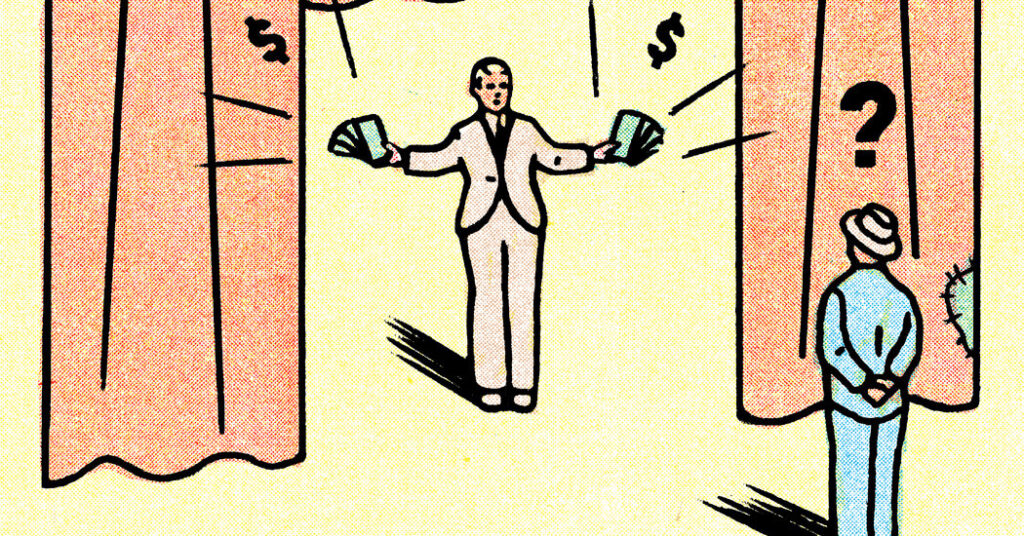Q: We borrowed $218,000 from a company called World Business Lenders and paid back more than $240,000 — but they said we still owe $200,000. This happened during Covid, when our business was shut down. When we couldn’t pay, they said they would take our house. This was a predatory loan, part of a rent-a-bank scheme. We need help, otherwise we will lose our family home of 60 years.
— Fred Urban, Brooklyn, N.Y.
Fred Urban’s situation is a classic study in how borrowers living in states like New York, which have consumer protections that cap interest rates, can still become entangled in loans carrying predatory rates, often with devastating consequences.
Mr. Urban, 58, and his wife own a German restaurant in Brooklyn called Schnitzel Haus. Just before the pandemic, they took out a loan with an interest rate that can both strain the eyes and play tricks with your mind: “0.147945205479 percent per day.” Multiply that by 365 days, and you arrive at their true interest rate — nearly 54 percent. But their loan documents didn’t describe it that way.
In New York, interest rates on many consumer loans are generally capped at 16 percent, and charging more than 25 percent can lead to criminal usury charges (there are some exceptions). So how could the Urbans end up with a rate that’s double that? Through what is known as a rent-a-bank scheme.
Here is how the scheme typically works: The borrower, often someone who is financially distressed or has a weak credit profile, applies for a loan through a nonbank lender. To bypass state interest rate caps, the nonbank lender will partner with (or “rent”) a chartered bank in another state. The chartered bank is generally free to “export” the higher rates permitted in its home state. The bank typically sells most (or all) of the loan right back to the nonbank that initiated the deal.
Who is the true lender in this situation? We’ll come back to that.
In 2019, the Urbans inherited Mr. Urban’s family home of about 60 years, in the Bay Ridge section of Brooklyn. It needed work, and they decided to take out a loan for the renovations, which they thought they could also use for their restaurant and to help their then 26-year-old son expand his own small business.
Mr. Urban said that they had wanted to borrow $100,000 to $150,000, but the loan brokers, who were securing a loan through the New Jersey-based World Business Lenders, pressured the couple to take out a larger loan, for $218,000. The brokers told the couple they would help them settle the loan, which was taken through their restaurant business, within six months — and the Urbans trusted them because they had used these brokers for business loans in the past.
They were also preoccupied. Just as the Urbans were finalizing the agreement, their lives were upended. Their son had a serious seizure in early April 2020, caused by undiagnosed epilepsy, and was declared brain dead. He remained on life support for a few days as his family arranged to donate his organs, just as the global pandemic was unfolding and businesses in New York were shuttered.
The loan brokers “were relentless to get us to close,” Mr. Urban said. “They called when we were in the hospital, texted all day long to see if we signed paperwork. We asked to be left alone at the time, but they continued to harass us to get it done.”
What they signed remains a blur. He hadn’t realized, he said in an interview, that his house was being used as collateral. “If I would have known,” Mr. Urban added, “I would have never done this loan.”
They had misgivings after the first month, and wanted to give the money back. But the prepayment penalties, which Mr. Urban recalls being roughly $80,000, were too steep. They were on the hook for two years of payments — interest only for the first year — and a giant balloon payment at the end.
They initially owed $2,257 weekly to World Business Lenders, but it would ultimately be a chartered partner bank, Axos, that would file for foreclosure on their home after they fell short on payments. Their restaurant remained open — offering takeout, deliveries and outdoor seating — but the pandemic business declined, and the couple still had to borrow from family, wipe out their savings and take out “merchant cash advances” to make their payments to World Business.
World Business Lenders did modify the loan several times when the Urbans missed payments, adding the arrears to the balance. But it sent them a default letter in July 2022, and demanded they immediately pay the entire loan sum, or their home was on the line. Axos initiated foreclosure proceedings a few months later.
At that point, a little more than two years after they started this journey, Mr. Urban said they had paid back about $240,000 on the $218,000 loan — though, when the loan had closed, he said they had received only about $185,000 after fees and closing costs.
The legal arguments contesting rent-a-bank arrangements have often centered around which entity serves as the true lender, or who had the “predominant economic interest” in the transaction. In most cases it’s the nonbank lender, advocates and legal experts said, since that’s the entity typically handling the entire transaction — both making and later carrying the loan and collecting payments.
But it can be challenging for borrowers who wish to go to court to prove which entity is the true lender. Adam Levitin, a professor at Georgetown Law who has published a paper on rent-a-bank partnerships, said that many of the facts needed to establish who the true lender is are often not publicly available.
In the past, Axos — with offices in Nevada, which generally has fewer rate restrictions — has sold these loans to World Business Lenders, experts said.
In the Urbans’ situation, Axos is the named lender on the loan documents and claims to have retained the loan, according to legal filings. But as Professor Levitin points out, it’s possible World Business Lenders purchased a “participation” in the loan — a derivative interest equal to a large percentage of the note.
“The loan itself stays on Axos’s balance sheet, so Axos is the party that ‘owns’ the loan, but almost all of the economic interest is transferred to WBL,” he said. “That’s how a lot of other rent-a-bank arrangements work these days. It’s all a beard.”
World Business Lenders did not respond to requests for comment. Axos declined to comment.
Even though the Urbans’ borrowing was backed by their family home, they received a business loan, which comes with far fewer consumer protections than personal credit. Indeed, under New York law, companies can’t claim civil usury — only criminal usury, which is more challenging to prove.
The Urbans have argued that Axos’s loan, among other things, was “criminally usurious,” making the loan void, and asked the courts to dismiss the foreclosure. But Axos prevailed in court. The couple had filed a Chapter 13 bankruptcy to stop all collection activity and is trying to retain a new lawyer.
The broader regulatory landscape remains complicated. At the end of the first Trump administration, the Office of the Comptroller of Currency issued a “true lender” rule, which said that the bank is the lender in a partnership with a non-bank if it’s named in the loan documents or funds the loan (even if it sold the loan back to the partner). Consumer advocates said the rule cleared the way for these and other high-interest schemes to proliferate — and undermines states’ abilities to protect their residents.
It didn’t last long. Congress, urged by consumer advocates, a bipartisan coalition of state attorneys general and others, overturned the rule, and their resolution was signed into law by President Joseph R. Biden Jr.
Most recently, a federal appellate court in Denver ruled that Colorado could opt out of a federal law that allows state-chartered banks located elsewhere to export high interest rates into the state. This decision could pave the way for other states to do the same, though the ruling could be challenged, advocates said.
“A banking charter is a privilege,” said Adam Rust, director of financial services at the Consumer Federation of America, “not a ticket to receive a share of profits from regulatory arbitrage.”
Kirsten Noyes and Susan Beachy contributed research.
Tara Siegel Bernard writes about personal finance for The Times, from saving for college to paying for retirement and everything in between.
The post A Family Borrowed $218,000 and Paid Back $240,000. Why Are They Facing Foreclosure? appeared first on New York Times.




